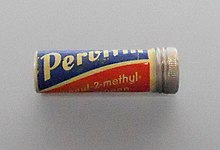Opium Act
The opium law , in the long title law on the traffic with narcotics , regulated the handling of narcotics in the German Reich from January 1, 1930 .
In the Federal Republic of Germany , the pre-constitutional Opium Act became federal law in accordance with Articles 123 and 124 of the Basic Law . After being renamed the “ Narcotics Act ” in the meantime , it was replaced by a new version dated July 28, 1981 ( Federal Law Gazette I p. 681) with effect from January 1, 1982.
history
In the original version of the Opium Act of 10 December 1929 ( RGBl. I p. 215), Section 1, Paragraph 1 lists the preparations in question: "Substances within the meaning of this Act are raw opium , opium for medical purposes, morphine , diacetylmorphine (heroin) , Coca leaves , raw cocaine , cocaine , ecgonine , Indian hemp and all salts of morphine, diacetylmorphine (heroin), cocaine and ecgonine. "
This was preceded by 1909, the International Opium Commission of Shanghai , where the initiative of the United States and Britain on the introduction of a global regime of Opium Prohibition was debated. The German Reich was represented at this conference and supported the position of the USA and China, which advocated stricter opium laws. The following opium conference in The Hague, which took place in December 1911 and January 1912, regulated international opium policy for the first time. The German Reich did not ratify the Hague Opium Convention until it was forced to do so by the Versailles Treaty in 1919.

The opium law goes back to a condition after the lost First World War , which said an implementation of the Hague Agreement of 1912 according to Art. 295 of the Versailles Treaty . This condition was first formally met with the law for the implementation of the International Opium Agreement of January 23, 1912 of December 30, 1920 (RGBl. 1921 p. 2). However, given the rather low regulatory content of this law in the Weimar Republic, opium derivatives or cocaine were still very common in medicine . With the Opium Act, these substances were then subject to prescription and were only legally available for medical purposes. However, it was still possible to obtain heroin and other narcotics from the pharmacy on presentation of a prescription . Amphetamine was included in the Opium Act in 1941.
Individual evidence
- ↑ Art. 1 No. 1 AA of December 22, 1971 ( Federal Law Gazette I p. 2092); Validity from December 25, 1971.
- ^ Helena Barop: Building the "Opium Evil" Consensus. The International Opium Commission of Shanghai, in: Journal of Modern European History 13, 1 (2015), pp. 115-137.
- ↑ Ulrich A. Hitler's Drugged Soldiers . Spiegel Online International May 6, 2005
